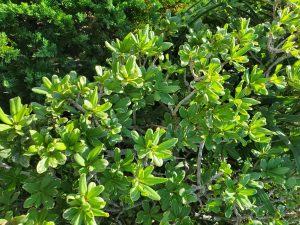
While many landscape plants have one or more common names that people recognize, the pittosporum is most often called just “pittosporum”. Many other names such as the Japanese mock-orange, Japanese pittosporum, and tobira have been used, but I don’t think that I would respond if I heard one of these aliases. The pittosporum is a hardy plant with several forms that make it a great landscape feature with a few fragrant flowers thrown in for good measure.
While I have seen the pittosporum kept as a houseplant inside up north, they make truly great landscape subjects in our area. This evergreen can be grown as a shrub or even a small tree up to fifteen feet tall with some training. The leaves, arranged in a whorl, are oblong in shape and up to five inches long. The edges of the leaves curl downward and inward adding to the attractive nature of the green foliage. Although the species is all-green, most of the pittosporum seen in local landscapes are the popular variegated types – likely the cultivar ‘Variegata’ – with glossy, creamy white and grey-green leaves. Young specimens will produce rapid growth and then slow as they reach the ten-foot-tall range. Although easily maintained to the size you want with selective pruning, some cultivars are normally dwarf by nature. ‘Wheeler’s Dwarf’ for instance grows to only about two feet in height with all-green foliage. This variety makes a great mounding specimen suitable for low-maintenance landscaping. Another dwarf cultivar, ‘MoJo’ has variegated foliage with compact growth up to 22 inches tall and three-feet wide.
The pittosporum is highly salt tolerant and is an ideal plant for coastal planting. Once established, this woody ornamental is also highly drought tolerant. However, the pittosporum does not tolerate wet soil and poor drainage. Too much water will initiate root rots, so be careful about site selection. For best results, plant in a part shade to sun location with spacing from thirty-six to sixty inches between plants.
An added feature of the pittosporum is the spring flowers. While the white to creamy yellow flowers are sometimes less noticeable on variegated types, they are very apparent on the all-green pittosporum. In addition to the showy nature, these flowers are highly fragrant reminding you of orange blossoms – thus the name Japanese mock-orange.
Besides specimens trained as a small tree, pittosporum are often used as hedge material, for mass planting and even in large containers or planters. Pittosporum foliage can be used in floral arrangements. Florida is actually home to commercial nurseries where this shrub is grown just to harvest its attractive foliage for flower arrangements. Pittosporum is clearly a great woody ornamental plant that will make a nice addition to your Florida-Friendly Landscaping™ plant palette! For information on all types of shrubs suitable for our area, you can also call the Master Gardener Volunteer Helpdesk on Mondays, Wednesdays and Fridays from 1 to 4 pm at 764-4340 for gardening help and insight into their role as an Extension volunteer. Ralph E. Mitchell is the Director/Horticulture Agent for UF/IFAS Extension – Charlotte County. He can be reached at 941-764-4344 or ralph.mitchell@charlottecountyfl.gov. Connect with us on social media. Like us on Facebook @CharlotteCountyExtension and follow us on Instagram @ifascharco.
Resources:
Gilman, E. F. (2014) Pittosporum tobira ‘Variegata’ Variegated Pittosporum. The University of Florida Extension Service, IFAS.
Landre, C. (2022) Variegated Pittosporum – Pittosporum tobira ‘variegata’. South-Florida-Plant-Guide.com.
Russ, K. (2007) Pittosporum. Clemson University Cooperative Extension Service.
Chase, A.R. & Simone, G.W. Professor (1986) Diseases of Pittosporum in Florida University of Florida.
The Florida-Friendly Landscaping™ Guide to Plant Selection & Landscape Design (2010) The University of Florida Extension Services, IFAS.
 1
1
